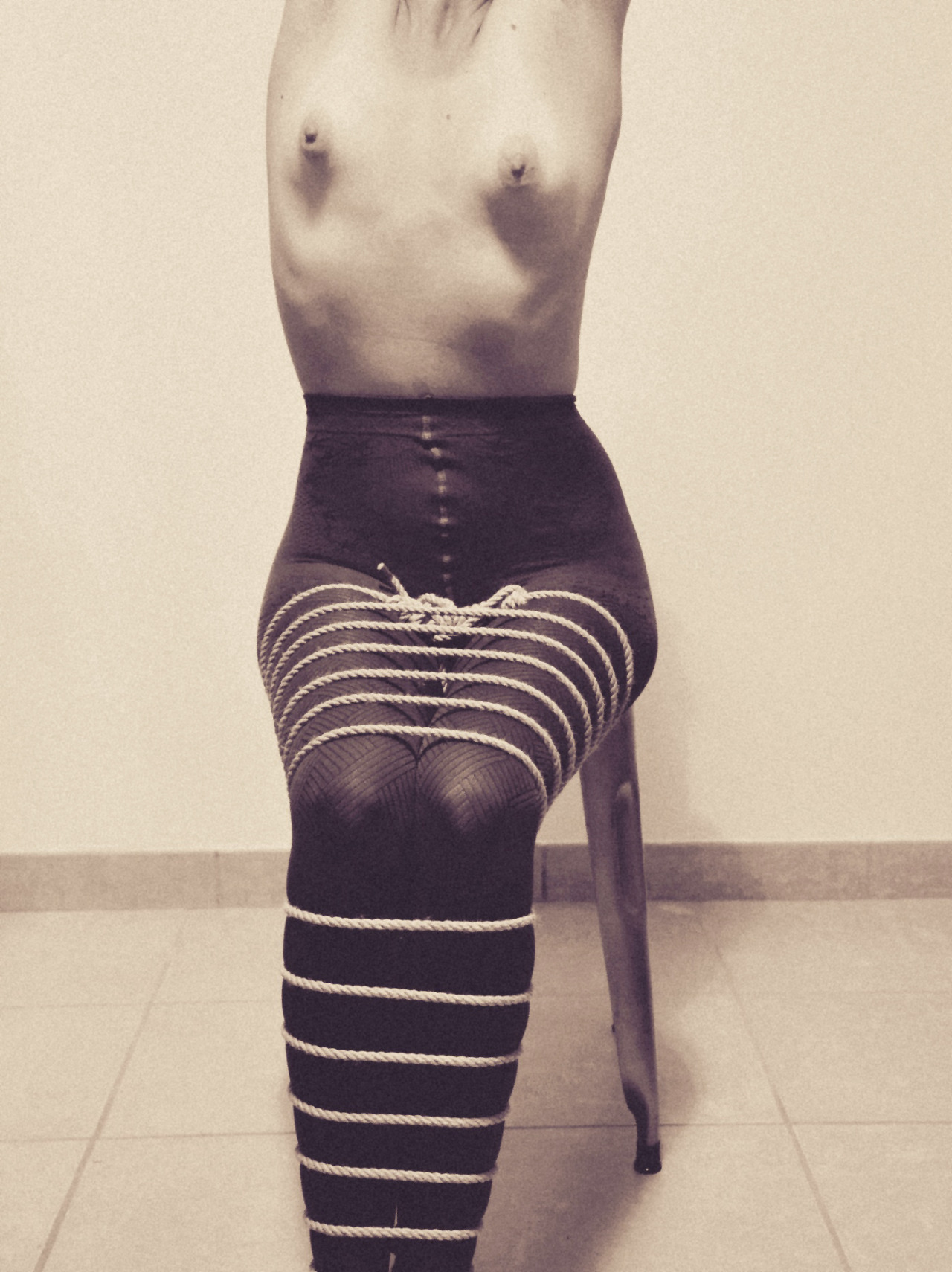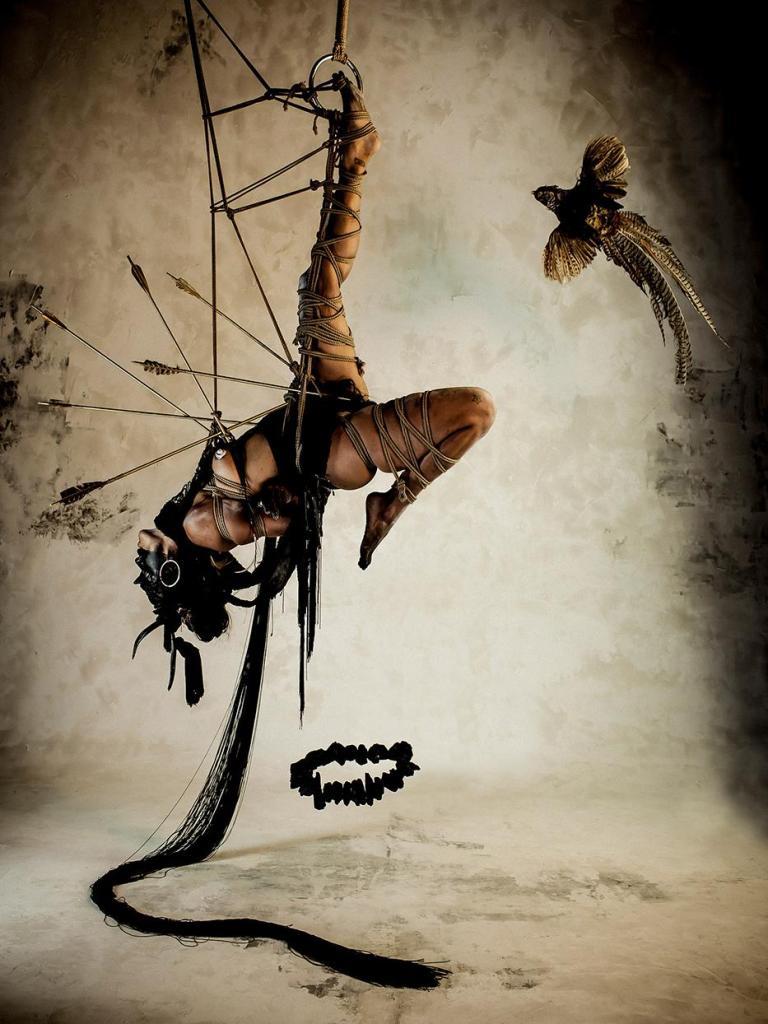Read Part 1 of our two-part series on kinbaku here.
This article contains adult content.
Videos by VICE
In recent years, kinbaku, erotic Japanese rope bondage, has catapulted into the Western limelight in films, music videos, performance, and visual art. Though it remains a fringe interest on the whole, convincing examples of the practice have made their way into to the mainstream. Most notably, Japanese photographer Nobuyoshi Araki has created a wealth of work illustrating rope bondage, even photographing Lady Gaga to that effect. In LA, Master “K,” author of the definitive text on the subject The Beauty of Kinbaku, tells me his tying services are in high demand. His collaborations with international artists include creating the rope costumes for Melanie Pullen’s Violent Times performance and tying models for fashion photographer Michel Comte.
Though artists have successfully incorporated the visual elements of rope in a variety of media, all too often, rope operates simply as decoration or artifact. While aesthetically compelling enough, these uses don’t capture the depth of kinbaku as understood by serious practitioners, who invariably describe rope as a language through which desire is expressed. Without shedding light on the process, however, kinbaku‘s art cameos can fall flat.

© Nobuyoshi Araki, courtesy TASCHEN from Nobuyoshi Araki. Bondage
Thankfully, there are examples to the contrary, where both the aesthetic and sensual properties of the practice seamlessly merge. Houston-based photographer Traci Matlock captures this overlap in her work, which ranges in tone from raw and explicit to poetically vague, though always challenges the viewer. Matlock was already documenting her life through her artwork when she began incorporating images of kinbaku, alongside other aspects of BDSM play, as she pursued them off camera.
These images developed in collaboration with her partner Nodorum, she explains in an email. “As our relationship expanded, so did what we were capable of achieving in both rope and art,” she says. “One acted as a catalyst for the other.” Tying, as Matlock and Nodorum do, “for artistic and sexual expression,” blurs art and life, lending an extreme level of intimacy to the work that honors the intensity of the physical and psychological dimensions of kinbaku.

Fashion spread in GQ Italia, 2012. Photography by Michel Comte, Rope by Master K. Courtesy of Master K
These artists are part of a milieu of practitioners on Instagram, who chronicle their exploits and progress with the enthusiasm of yogis on yerba mate. Dojos and dungeons increasingly offer classes in the art of tying, coaxing those already disposed towards BDSM. Eager newbies at an introductory class at LA Rope Dojo had discovered the practice through an art performance and sex event. The workshop taught historical context, witnessed ties modeled and practiced tying under supervision with a partner.

Bondage Erotique by Evelyn Henriquez. Image courtesy of the artist.
Images of kinbaku can certainly be triggering to viewers, especially those unaware of the meditative aspects of the practice. At face value, a woman in rope bondage within a patriarchal culture can seem like a vexing exacerbation of male dominance. On the other hand, it can be argued that kinbaku exhibits an open expression of female sexual desire (which might include wanting to be tied) as a testament to some erosion of the patriarchy. Context plays an important role.
Many female creators are opting to incorporate kinbaku into artwork that is personal. For instance, Monica Canilao approached the technique to document a process of healing through art. Performance artist Millie Brown tested her own endurance when she had herself tied, inverted, suspended, and swung for Pendulum. Others take the rope into their own hands, like French photographer Nina Scceletton who taught and ties herself for self-portraits of auto-erotic experience.

Live performance by artist Melanie Pullen. Title: Violent Times. Los Angeles. 2017. Still #3, Shot by Melanie Pullen
Last year, instructor/performer Blue, co-founder of Bondage Erotique in the Bay Area, launched a series of classes called Women Tying Women at the SF Armory, which have consistently sold out, joining the ranks of other female-forward groups like Hitchin’ Bitches, which has 40 chapters internationally. Blue began studying rope as a bottom with her partner Kanso, but over the course of her career, her role changed to that of “switch,” moving between dominant and submissive roles.
“Something is happening and shifting,” she says, describing the outpouring of women interested in rope. She distinguishes her classes as a place to “address long-standing gender dynamics and expectations and push against them, turn them upside down, remove them even.” Cisgender men can attend, but only as bottoms, she says. That might seem like an inversion of power dynamics, but instructors across the board agree that many more men like to be tied than are currently represented in kinbaku media, which largely recreates heteronormative configurations of power with man as dominator and woman as submissive.

Image courtesy of Nina Scceleton
Despite the upswing in popularity that has allowed kinbaku to occasionally edge into mainstream culture, for the moment, the serious study of the art is staunchly situated in the underground. As the practice gains a more significant hold in the alternative visual lexicon, and as access to kinbaku information multiplies, we can expect inflation. To the curious: approach with intelligence.
To learn more about kinbaku history, influential masters and art appearances, pick up a copy of the celebrated volume by Master “K,” The Beauty of Kinbaku.
Related:
[NSFW] A Brief History of Japanese Rope Bondage
[NSFW] Erotica and Manga Mingle in This Bisexual Illustrator’s Surreal Fantasies
[Exclusive] ‘Samurai Jack’ Creator Genndy Tartakovsky on Why the Show Is Getting Darker




